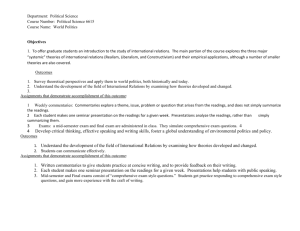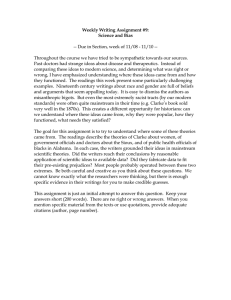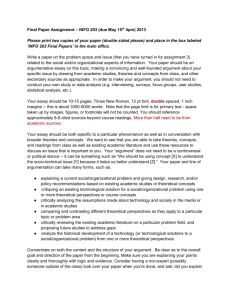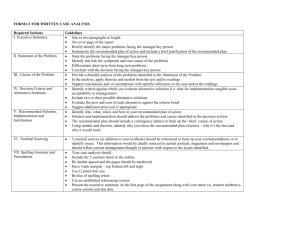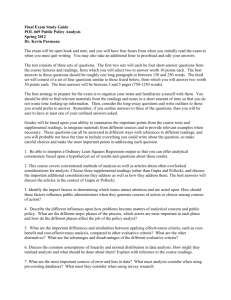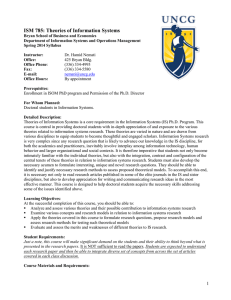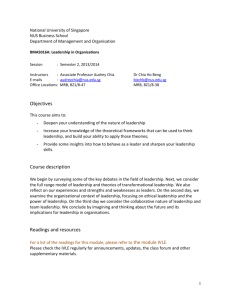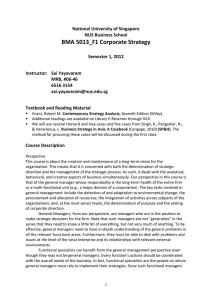COURSE OUTLINE BSP3001C Business Policy & Strategy
advertisement
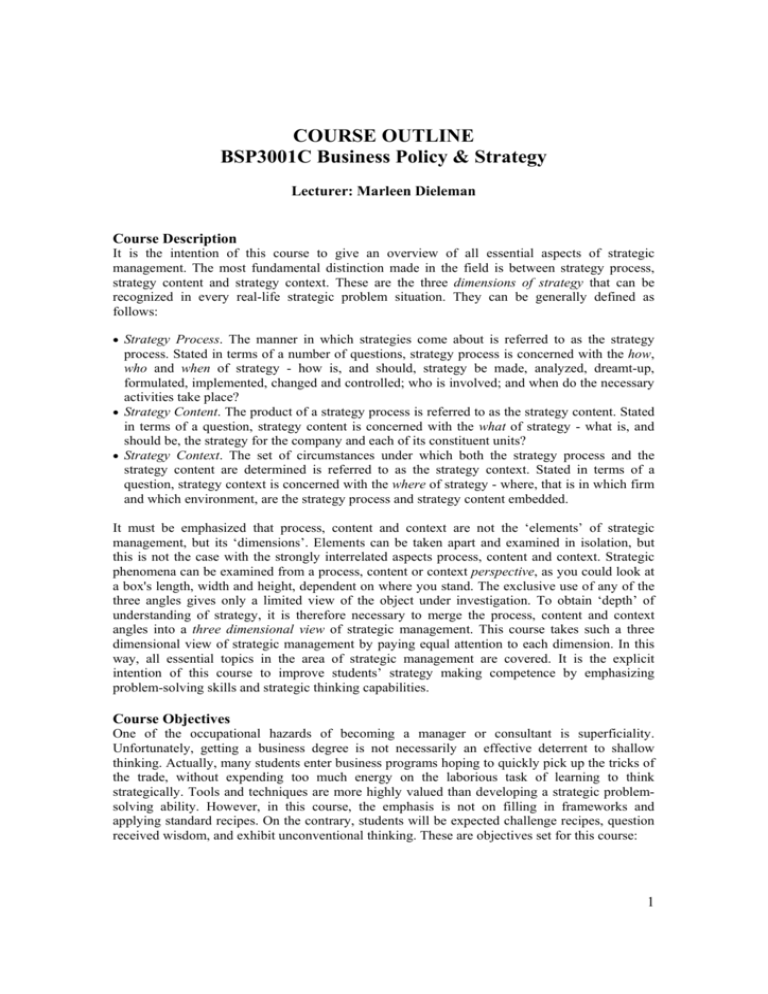
COURSE OUTLINE BSP3001C Business Policy & Strategy Lecturer: Marleen Dieleman Course Description It is the intention of this course to give an overview of all essential aspects of strategic management. The most fundamental distinction made in the field is between strategy process, strategy content and strategy context. These are the three dimensions of strategy that can be recognized in every real-life strategic problem situation. They can be generally defined as follows: • Strategy Process. The manner in which strategies come about is referred to as the strategy process. Stated in terms of a number of questions, strategy process is concerned with the how, who and when of strategy - how is, and should, strategy be made, analyzed, dreamt-up, formulated, implemented, changed and controlled; who is involved; and when do the necessary activities take place? • Strategy Content. The product of a strategy process is referred to as the strategy content. Stated in terms of a question, strategy content is concerned with the what of strategy - what is, and should be, the strategy for the company and each of its constituent units? • Strategy Context. The set of circumstances under which both the strategy process and the strategy content are determined is referred to as the strategy context. Stated in terms of a question, strategy context is concerned with the where of strategy - where, that is in which firm and which environment, are the strategy process and strategy content embedded. It must be emphasized that process, content and context are not the ‘elements’ of strategic management, but its ‘dimensions’. Elements can be taken apart and examined in isolation, but this is not the case with the strongly interrelated aspects process, content and context. Strategic phenomena can be examined from a process, content or context perspective, as you could look at a box's length, width and height, dependent on where you stand. The exclusive use of any of the three angles gives only a limited view of the object under investigation. To obtain ‘depth’ of understanding of strategy, it is therefore necessary to merge the process, content and context angles into a three dimensional view of strategic management. This course takes such a three dimensional view of strategic management by paying equal attention to each dimension. In this way, all essential topics in the area of strategic management are covered. It is the explicit intention of this course to improve students’ strategy making competence by emphasizing problem-solving skills and strategic thinking capabilities. Course Objectives One of the occupational hazards of becoming a manager or consultant is superficiality. Unfortunately, getting a business degree is not necessarily an effective deterrent to shallow thinking. Actually, many students enter business programs hoping to quickly pick up the tricks of the trade, without expending too much energy on the laborious task of learning to think strategically. Tools and techniques are more highly valued than developing a strategic problemsolving ability. However, in this course, the emphasis is not on filling in frameworks and applying standard recipes. On the contrary, students will be expected challenge recipes, question received wisdom, and exhibit unconventional thinking. These are objectives set for this course: 1 • Knowledge. To encourage the understanding of the many, often conflicting, schools of thought and to facilitate the gaining of insight into the assumptions, possibilities and limitations of each set of theories; • Skills. To develop the student's ability to define strategic issues, to critically reflect on existing theories, to creatively combine or develop theories where necessary and to flexibly employ theories where useful; • Attitude. To instill a critical, analytical, flexible and creative mindset, which challenges organizational, industry and national paradigms and traditional problem-solving recipes. Course Format The format of the course is based on a mixture of cases and theory. It is my belief that understanding both practice and theory, and acquiring the skill to apply one to the other, should be the core of this course. Classes will not be used to review theory which is in the book (this is the student's individual responsibility), but will be employed to give clarifying examples of issues discussed in the chapters and readings, and for case discussion. The case discussion should be guided by insights gained in the 'theoretical' readings and should lead to conclusions about the applicability of theoretical concepts in certain practical situations. I apply a 3-stage approach to learning with cases: 1. students thoroughly prepare the case at home; 2. in class students discuss their analysis in a small group; 3. there is a plenary discussion in class. This will allow students to compare and ideas and learn from each other. Learning comes not only from understanding new concepts and applying analytical skills. Debating with others will sharpen someone’s analytical skills considerably and will help students to communicate their ideas clearly. Sometimes guest speakers are invited. In general, classes will be structured in the following way: Introduction to concepts Small Group Case Discussion Break Plenary Case Discussion Conceptual Wrap-Up 50 min 30 min 15 min 75 min 10 min In each of the classes the students should come prepared by reading the required materials in advance (chapter, readings and case). The students should be ready to be asked to volunteer to open the discussion, do a short presentation, or answer specific questions regarding the case or other readings. Active participation from the students is a condition for the success of the course. The quality of your preparation and class input will be reflected in your participation grade. Absence from classes or remaining silent will have a negative effect on your participation grade. Course Schedule In the table below a further detailing of the contents per class session is given. Week January 15, 2010 January 22, 2010 January 29, 2010 February 5, 2010 February 12, 2010 February 26, 2010 March 5, 2010 March 12, 2010 March 19, 2010 March 26, 2010 April 2, 2010 Session 1 2 3 4 5 6 7 8 9 10 11 Topic Introduction to Strategy Strategic Thinking Strategy Formation Strategic Change Business Level Strategy Corporate Level Strategy Network Level Strategy Industry Context Organizational Context International Context Organizational Purpose Reading Chapter 1 Chapter 2 Chapter 3 Chapter 4 Chapter 5 Chapter 6 Chapter 7 Chapter 8 Chapter 9 Chapter 10 Chapter 11 Case Disney Virgin Kao Corporation IMC Group* Rodamas Group* Salim Group* LoJack Global Wine Wars* Chicago Museum KFC Nike 2 April 9, 2010 April 16, 2010 April 24-May 8, 2010 12 13 Organizational Purpose Project Presentations Exam Period Chapter 11 Nokia in China** * Cases available on IVLE. ** The case will be a film, to be shown in class. No preparation required Grading and Assignments The final grade for this course will be computed based on the following: Class Participation Group Project Final Exam 20% 35% 45% (April 12, 3pm, upload on IVLE) • The class participation grade will be based on the quality, not the quantity, of participation. Absence from class sessions will result in a lower participation score. • There is an ongoing joke regarding business graduates. On their first day in the company they ask: “where is the case”? Real life problems are never neatly summarized and presented in the form of a case. Strategy problems are messy and the way you research them is important in solving these “messes”. The group project gives you an opportunity to research a company or organization, apply your consultancy skills, and make a strategic plan for the CEO. More details regarding the group project will be made available in class. • The final exam will consist of a case with a small number of questions. The questions will require students to be able to apply their knowledge of theoretical concepts to the practical case situation. This exam requires no memorization and is therefore open book. This exam does require deep understanding of the strategy concepts and extensive practice in the application of theory to a business situation. The best preparation for both is class participation. Literature De Wit, Bob, and Ron Meyer (2004), Strategy - Process, Content, Context: An International Perspective, third edition, London: Thomson Learning. 3


